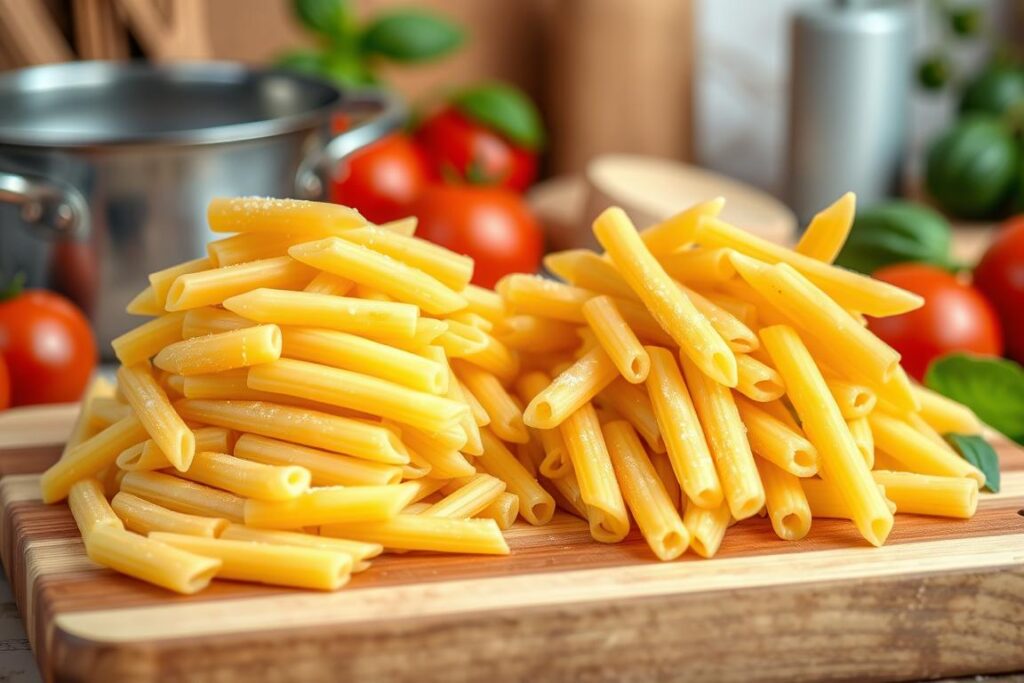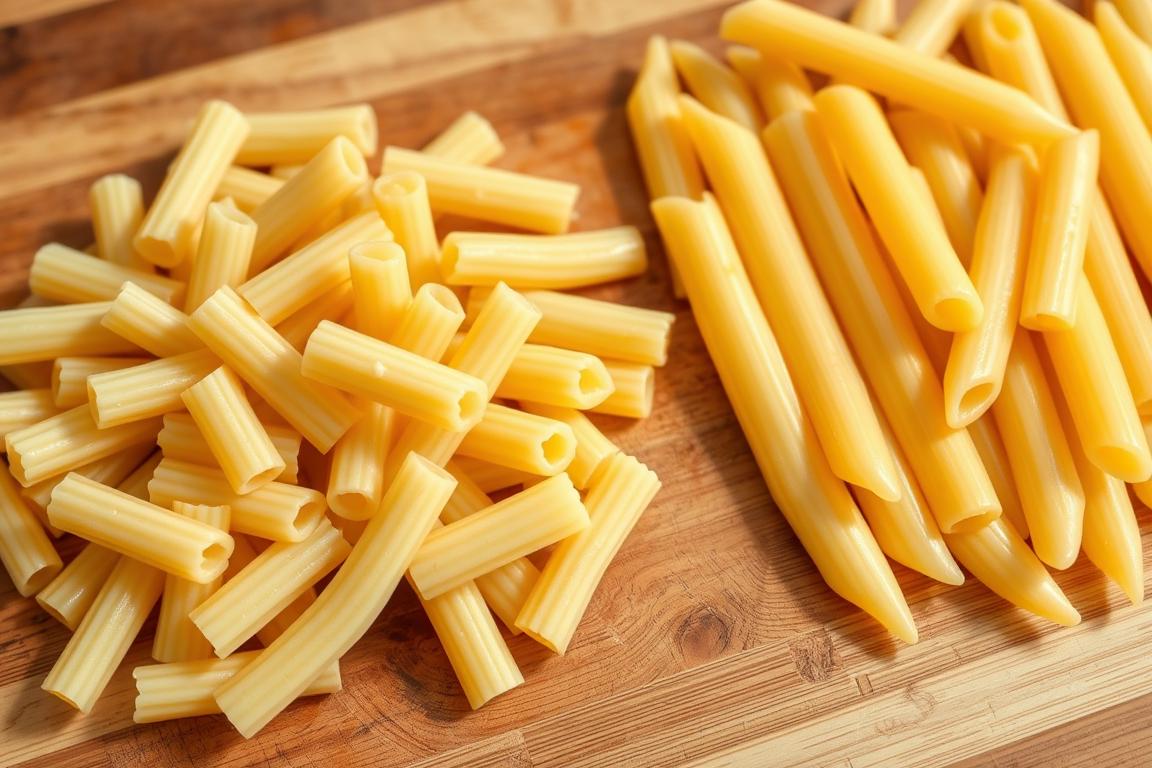Ever wondered how choosing the right pasta can change your dish? In the world of pasta, knowing the differences between rigatoni and penne is key. They are both tubular pasta but have unique traits. This article explores their distinct features, uses in cooking, and their importance in Italian food.
Key Takeaways
- Rigatoni and penne are two popular types of tubular pasta.
- Each pasta shape has its own unique characteristics that affect cooking and presentation.
- Understanding the differences can enhance culinary experiences.
- Both shapes offer versatility in various Italian dishes.
- Choosing the right pasta can elevate the flavor and texture of meals.
Introduction to Tubular Pasta Shapes
Tubular pasta shapes are key in the world of pasta. They’re great at holding onto sauces and ingredients. Knowing about the different types of pasta can make cooking more fun. It helps find the perfect match for sauces and toppings.
These shapes have a deep history in Italian food. They add a special texture that makes meals more filling. Traditional recipes show how shapes like rigatoni and penne work well in many dishes, from big casseroles to light salads.
Each type of tubular pasta changes the feel and flavor of a dish. They play a big role in Italian cooking, making food look good and taste great. Here’s a look at some popular shapes:
| Pasta Shape | Texture | Culinary Uses |
|---|---|---|
| Rigatoni | Ridged, thick | Perfect for rich sauces, baked dishes |
| Penne | Smooth, slanted cut | Great for salads, light sauces, and soups |
| Ziti | Similar to penne, slightly larger | Often used in baked pasta dishes |
| Tortiglioni | Spiraled ridges | Holds sauces exceptionally well |
Defining Rigatoni and Penne
Learning about the unique qualities of tubular pasta can boost your cooking skills. Rigatoni and penne are great examples. Each has its own special traits that fit different dishes perfectly.
Characteristics of Rigatoni
Rigatoni is known for its short, wide shape and ridged surface. These features help it hold onto sauces well. The ridges are great for holding onto thick, chunky sauces. This makes rigatoni a top pick for filling meals.
Its straight cut also sets it apart. It gives a strong texture that goes well with many ingredients.
Characteristics of Penne
Penne is famous for its diagonal cuts and comes in smooth and ridged types. This shape lets penne hold onto sauces in a unique way. The smooth type works well with light sauces, while the ridged version catches bits of veggies or meat.
| Characteristics | Rigatoni | Penne |
|---|---|---|
| Shape | Short, ridged, straight cut | Diagonal cut, smooth or ridged |
| Circumference | Larger | Smaller |
| Best Suited For | Thicker sauces | Lighter or chunkier sauces |
| Texture | Firm and ridged | Smooth or ridged |
What is the difference between rigatoni and penne?
Rigatoni and penne differ mainly in their shape and size. Rigatoni has a broad, straight cut and is larger. Penne is slender with a diagonal cut at each end. These shapes affect how they are used in cooking.

Rigatoni is often ridged, which makes it great for holding onto sauces. Penne can be smooth or ridged too. Knowing these details helps us enjoy tubular pasta more in Italian dishes.
| Feature | Rigatoni | Penne |
|---|---|---|
| Cut Style | Straight | Diagonal |
| Size | Larger diameter | Smaller diameter |
| Surface Texture | Ridged | Smooth or Ridged |
| Common Uses | Hearty sauces, baked dishes | Light sauces, pasta salads |
Shapes and Cuts of Pasta
Knowing the different shapes of pasta is key to making various dishes. Each shape has its own role in cooking, especially with penne and rigatoni. Let’s explore how these shapes are cut.
Diagonal Cuts of Penne
Penne is known for its diagonal cuts, like a feather’s quill. This design makes it look great and helps it hold sauce well. The angled ends give more surface area for sauces, making it great for flavorful dishes.
Straight Cuts of Rigatoni
Rigatoni has straight cuts with square ends. This gives it a tubular shape that’s wider than penne. The square edges add texture, helping sauces stick and improving flavor. Rigatoni is perfect for baked pasta or thick sauces.
Comparison of Size and Circumference
A pasta size comparison shows big differences between penne and rigatoni. Penne is slender, while rigatoni is fuller. Here’s a table with their main features:
| Pasta Shape | Cut Type | Diameter | Length |
|---|---|---|---|
| Penne | Diagonal | 1.5 cm | 4 cm |
| Rigatoni | Straight | 2.2 cm | 5 cm |
The rigatoni cuts and penne cuts affect the sauces and dishes they’re used in. They each bring something special to pasta dishes.
Texture Differences: Smooth vs. Ridged
The texture of ridged and smooth pasta affects how they work in cooking. Knowing these differences can make cooking easier and tastier. For example, ridged pasta like rigatoni has ridges that help sauces stick. Smooth pasta, like penne, interacts with sauces differently.
Ridged Pasta: Benefits for Sauces
Ridged pasta, especially rigatoni, is great with many sauces. Its ridges let sauces cling better. This makes it perfect for thick sauces like meat ragu or creamy Alfredo. Chefs and home cooks use this to make sure flavors blend well.
Smooth Pasta: When to Use
Smooth pasta, like penne, is best with light sauces. It goes well with fresh tomato or olive oil sauces. Its smooth surface gives a clean taste that’s great with vegetables or seafood. Knowing this can really improve your cooking.
| Type of Pasta | Pasta Texture | Best Sauce Pairing | Culinary Uses |
|---|---|---|---|
| Ridged Pasta (e.g., Rigatoni) | Ridged | Thick Sauces (e.g., Ragu, Alfredo) | Hearty Dishes |
| Smooth Pasta (e.g., Penne) | Smooth | Light Sauces (e.g., Tomato, Olive Oil) | Delicate Dishes |
Common Culinary Uses for Each Pasta Shape
Learning about rigatoni and penne pasta shapes can make cooking more fun. Each shape plays a special role in different dishes. This makes the flavors and textures better. People choose between rigatoni and penne based on the sauce and how they cook it.
Dishes Best Suited for Rigatoni
Rigatoni is great for hearty dishes that need a lot of sauce. Its ridged surface holds onto the sauce well. This makes it perfect for recipes like:
- Rigatoni all’Amatriciana, featuring a flavorful tomato sauce with pancetta.
- Baked rigatoni with cheese, which creates a delightful crispy top.
- Rich Bolognese sauce served over rigatoni, allowing for a satisfying bite.
These dishes show how versatile rigatoni is in modern Italian cooking.
Dishes Best Suited for Penne
Penne is ideal for lighter dishes and versatile recipes. Its smooth surface pairs well with many sauces. Some popular dishes with penne are:
- Penne alla Vodka, which combines a creamy tomato and vodka sauce.
- Fresh pasta salads, using vibrant vegetables and olive oil.
- Classic marinara sauce, providing a perfect balance of flavor.
These dishes show how adaptable penne is, making it a favorite in many kitchens. For more info on pasta shapes, check out this informative source.
Substituting Rigatoni and Penne in Recipes
Many cooks ask if they can swap rigatoni and penne pasta without issues. Both types of pasta work well with sauce, but they have different textures and shapes. This can change how a dish tastes and feels.
Rigatoni is big and thick, perfect for hearty meals. Penne is better for lighter dishes. When swapping these pastas, think about how they’ll change the flavor and look of your dish.
At times, you can swap rigatoni or penne without big changes in taste. But, cooking times might vary, so watch the clock while you cook.
Knowing what makes each pasta special helps in making good substitutions. By trying different options, cooks can find new textures and tastes that make their dishes better.
Pasta Varieties: Exploring Other Options
Exploring the world of pasta reveals a wide range of shapes, each with its own special qualities. Tubular pastas like ziti are great because they hold sauces well. These options make cooking more fun and bring out the best in Italian food.
Similar Tubular Pastas: Ziti and Others
Ziti is a favorite in Italian kitchens for its smooth shape and great with many sauces. Candele and cannelloni are similar but have their own special uses. Candele is great for stuffing, and cannelloni is perfect for baked dishes. Trying out these shapes can spark creativity in the kitchen.
How Rigatoni and Penne Fit into Italian Cuisine
Rigatoni and penne are key to traditional Italian cooking, each with its own unique texture and taste. Rigatoni’s ridges are perfect for holding onto hearty sauces, making it great for meat dishes. Penne, with its angled cuts, is ideal for lighter dishes and salads. Using these shapes in your cooking brings a taste of Italy to your table. For more tips on using these shapes, click here.
Cooking Tips for the Perfect Pasta Dish
Getting the perfect pasta dish is all about knowing the right steps. Here are key tips to make your pasta preparation better. These tips will make your meals more enjoyable.
- Timing is crucial: Stick to the cooking time on the pasta package, usually 8 to 12 minutes. Check if it’s al dente a minute or two early.
- Salting the water: Adding salt to the boiling water boosts the flavor. Use 1-2 tablespoons of salt for every 4-6 quarts of water.
- Reserve pasta water: Before draining, keep a cup of pasta water aside. This liquid can help adjust sauce thickness if needed.
- Combining pasta and sauce: For the best taste, mix pasta and sauce in a skillet. Let them blend for a minute to coat the pasta well.
Using these tips will make any rigatoni or penne dish perfect. Practice these methods to improve your cooking skills. You’ll impress everyone with your delicious pasta dishes.

| Cooking Tip | Description |
|---|---|
| Timing | Cook according to the package instructions, testing for al dente. |
| Salting | Add salt to boiling water for enhanced flavor. |
| Reserve Water | Save pasta water for sauce consistency adjustments. |
| Combine | Mix pasta with sauce in a skillet for optimal flavor. |
Conclusion
Learning the differences between rigatoni and penne makes cooking at home more fun. Rigatoni fits well with thick sauces because of its big, ridged tubes. Penne, with its diagonal cuts, is great for light, creamy sauces.
Trying out both pasta shapes can lead to new favorite dishes. You might find that rigatoni works well in baked dishes or that penne is perfect for salads. These versatile pastas encourage cooks to try new things.
Choosing the right pasta shape is key in Italian cooking. It can change how a meal tastes and looks. Next time you plan a meal, think about how rigatoni and penne can enhance your dish. For more tips and ideas, check out this guide at Pubblico Italian Eatery.


